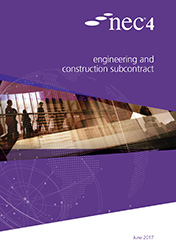
The main contract between the Client and Contractor for general building/construction type projects is the Engineering and Construction Contract. It is subdivided into options, of which the Client will choose either option A, B, C, D, E or F. This bulletin will consider the specific elements of option E & F for both tendering purposes and administering a live project.

Option E Cost Reimbursable Contract: As the name suggests the Contractor is literally paid on a cost reimbursable type basis. This option is likely to be suitable when the works are very urgent or where the scope is not well defined, or where the risk would be considered so great to the Contractor it may not be commercially viable for a Contractor to price it under a lump sum or even target cost type arrangement. The Contractor is paid (Price for Work Done to Date) their Defined Cost each period for what the Contractor forecasts they will have been paid before their next assessment date plus their Fee. In simple terms, this means actual cost the Contractor can prove they have already spent, and a forecast of their spend up until the end of the following period. The intent here is that by the time the Contractor actually receives payment (typically 3-4 weeks after they submit their application), it should be in line with what they have actually spent enabling a sensible cashflow for the Contractor. If the forecast proves to have been wrong it does not matter too much as in the following period the cumulative costs will be actualised in line with what they have spent that month, and now include a forecast for the following period. There is significantly less risk to a Contractor due to the way they are being paid compared to other ECC options, but equally less opportunity to improve on margins, as they are only paid (in addition to the actual cost incurred) their fixed fee percentage. This fee percentage is fixed as part of their tender submission in contract data part 2. There is no option E “tender price” given at tender stage like there is for options A-D, hence the only cost element being competitively tendered is the Contractor’s fee percentage.
Option E Defined Cost: The Contractor is paid in line with the relevant elements of the Schedule of Cost Components less any Disallowed Cost.

Option F Management Contract: This is by far the least commonly used ECC option and only suitable in very specific contractual arrangements. It is still a cost reimbursable type contract but for where the Contractor is managing a series of subcontract packages on behalf of the Client (although it is possible for the Contractor to do some work themselves). How the Contractor is paid is the same principles as option E above, in the sense that they are paid actual cost and always forecasting one period ahead to maintain a sensible cashflow for the Contractor.
Option F Defined Cost: Schedule of Cost Components is NOT relevant to option F and the Contractor is paid the amount of payments due to Subcontractors, and prices for any work done by the Contractor (plus Fee)

Disallowed Costs (for both options E and F) Disallowed Costs are defined in clause 11.2(26) and 11.2(27) respectively. As the names suggest these are costs that can be disallowed from what the Contractor is claiming each period. It is important therefore for everyone in the Contractor’s team to understand what these are so that they can avoid them being incurred and affecting the amount that they will be paid overall. Some of the more significant ones are costs that:
- are not justified by Contractor records and accounts (E&F)
- should not have been paid to a Subcontractor or supplier in line with its contract (E&F)
- were incurred because the Contractor did not give an early warning (E&F)
- not following an acceptance or procurement procedure stated in the Scope (E&F)
- correcting defects after Completion (E only)
- Plant and Materials not used to Provide the Works (E only)
- Resources not used to Provide the Works (E only)
- Payment to a Subcontractor which the Contract Data states the Contractor will do itself (F only)
This is an area where, through Z clauses, the Client may add extra elements that would also be Disallowed costs, so it is important to check and understand these amendments for any specific project as to the altering of a Contractor’s risk profile. Given the Contractor is only recovering actual costs plus their fee, it would not take many disallowed costs to significantly impact a Contractor’s margin and even mean they could lose money on what on paper is a low-risk contract option for a Contractor.
Compensation Events for option E: Any compensation events will be built up from first principles using the Schedule of Cost Components. The quotation that the Contractor puts forward for that event will help the Client with their own budgeting and forecasting. The Contractor is, however, paid “actual cost” for any compensation event so the quotation is simply for budgeting purposes. The time element of the quotation is particularly important though, as the implementation of the compensation event will also agree the movement of any Key Date or Completion Date. Otherwise, the Contractor may be liable for delay damages or cost incurred by the Client if these milestones are not achieved.
The Schedule of Cost Components is made up of eight categories that the Contractor would be able to claim relevant costs for when assessing their Defined Cost each period (typically every four weeks or monthly):
- People – more detailed than the Short Schedule of Cost Components and built up from first principles rather than pre-agreed People Rates that are used in options A and B. The NEC4 2023 amendments also include more specific rules to allow for people working from home which is now much more common post-Covid
- Equipment – e.g. amounts for hire of equipment, charge out rates for Contractor owned equipment, price for consumed equipment, price for transporting to/from the working area.
- Plant and Materials – for all permanent works that are installed such as pipework, cladding, cabling etc.
- Subcontractors – a new category for NEC4 where Subcontractors costs can now be included as a lump sum, rather than having to break it down into the other categories listed.
- Charges – for example, services into the site to run offices welfare, disposal of materials from site, charges for access to the Working Areas
- Manufacture and Fabrication – rates for people involved in manufacture and fabrication of Plant and Materials outside the Working Areas.
- Design – rates for people involved in design done outside the Working Areas, as well as cost of travel expenses when entering the Working Areas.
- Insurance – which only confirms that you cannot claim for insurable events or insurance premiums.
Compensation Events for option F: There is no Schedule of Cost Components for option F and these will be assessed as the amount that the Subcontractor will incur in line with their contract, and then the Contractor will simply apply their own fee percentage as identified in contract data part 2.

Differences with the Engineering and Construction Subcontract (ECS) The Contractor should be looking to pass their contractual obligations with their supply chain on a back-to-back basis. The ECS allows the Contractor to do exactly that. The rules, principles and even clause numbers are almost identical in the ECS as they are in the ECC. Everything in this bulletin therefore applies to the Subcontractor in relation to their Contractor if they are engaged under an ECS option A-E (no option F in the ECS). The only real changes between the ECC and ECS are that the names of the Parties change (from Client/Contractor to Contractor/Subcontractor), and that some of the timescales change for a Subcontractor to do something within, and for the Contractor to respond. A Contractor engaged with their Client under option E does not have to choose the same option for their Subcontractor. They may consider that by the time they are procuring that Subcontractor, that the risk profile is better understood and more manageable by the Subcontractor so can choose option A -D for that contractual arrangement.
Summary: Option E is a purely cost reimbursable type contract where the Contractor is paid on an actual cost basis plus their fee. The Contractor has minimal risk other than to ensure that the fee percentage is adequate, getting time entitlement agreed within any compensation events, and ensuring disallowed costs are fully understood and avoided if at all possible.
Option F is very rarely used but is a pure management type contract where the Contractor is managing a series of subcontract packages of work for the Client. They carry the same risk profile as option E, with the added risk of any work they will carry out themselves.

